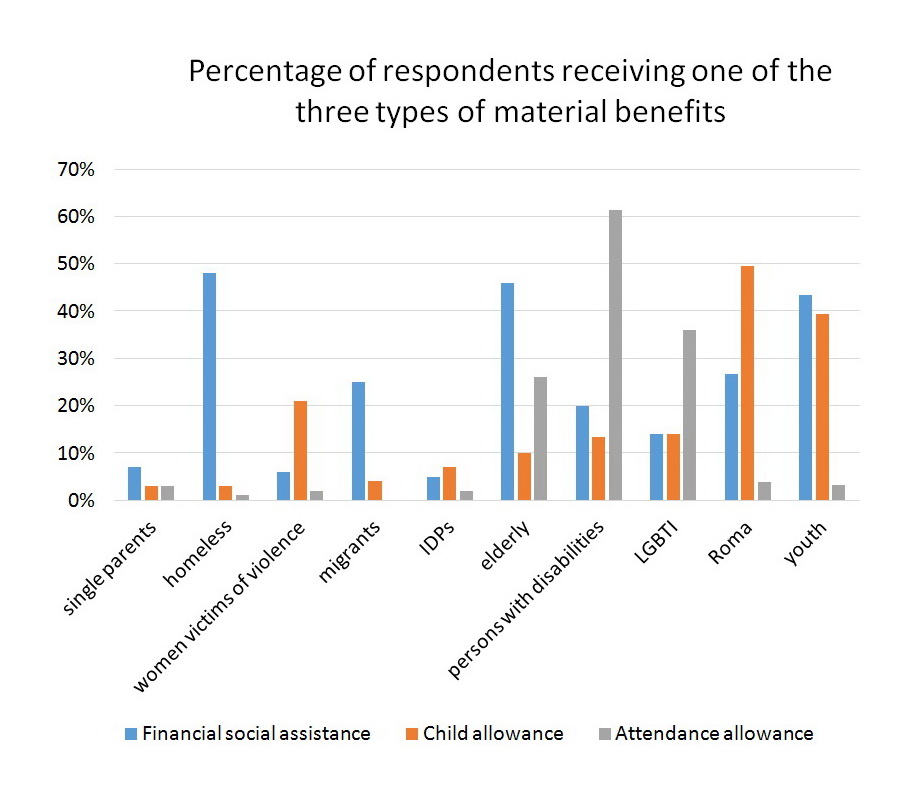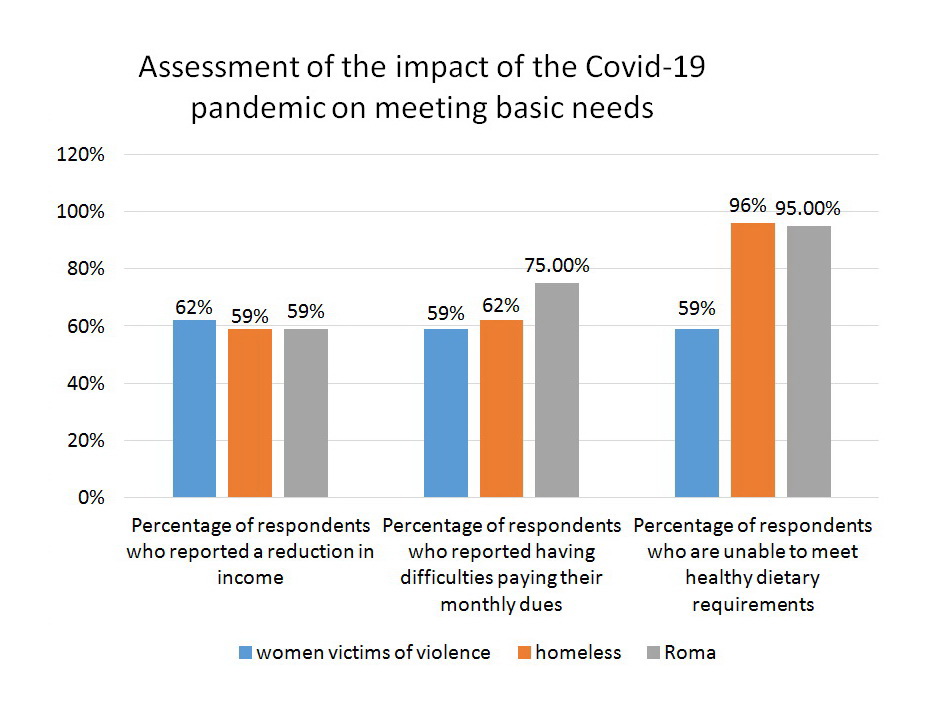 The Social Inclusion and Poverty Reduction Unit of the Government of Serbia, in cooperation with civil society organizations and a marketing research agency[1], conducted a survey to assess the impact of the COVID-19 pandemic on the income and consumption of vulnerable groups[2]. The survey was implemented from July to August of 2020 and included 2,006 respondents from vulnerable sections of the population from eight local government units[3] in Serbia. The respondents were asked to report any changes in the structure of income and consumption experienced by their household during the COVID-19 pandemic as well as their expectations for the next quarter. In addition, they were asked to provide feedback on the adequacy of the measures taken by the state in response to the COVID-19 pandemic and assess the need for additional measures, should the epidemiological crisis persist.
The Social Inclusion and Poverty Reduction Unit of the Government of Serbia, in cooperation with civil society organizations and a marketing research agency[1], conducted a survey to assess the impact of the COVID-19 pandemic on the income and consumption of vulnerable groups[2]. The survey was implemented from July to August of 2020 and included 2,006 respondents from vulnerable sections of the population from eight local government units[3] in Serbia. The respondents were asked to report any changes in the structure of income and consumption experienced by their household during the COVID-19 pandemic as well as their expectations for the next quarter. In addition, they were asked to provide feedback on the adequacy of the measures taken by the state in response to the COVID-19 pandemic and assess the need for additional measures, should the epidemiological crisis persist.
Financial security and material benefits
Most respondents reported that the COVID-19 epidemic had no impact on the work activity of the household member with the highest income, in other words, that nothing changed relative to the pre-crisis period. Where the work activity was impacted by the Covid-19 epidemic, in most cases it was in terms of income reduction. When we look at households that were not affected by changes in the employment status of the household’s highest wage-earner during the crisis caused by the Covid-19 pandemic, members of all vulnerable groups (except Roma, homeless and migrants) were optimistic with respect to the prospects of retaining their current employment. Thus, almost 70% of single parents, 75% of the elderly, 66% of women victims of violence and more than half of the respondents with disabilities and youth have a positive attitude regarding this issue.
Most respondents from vulnerable groups are receiving some form of financial benefits from the state. The elderly, the homeless and youth account for the largest share in the total number of recipients of financial social assistance. Child allowance is the most prevalent type of benefit in Roma families (49%). The dominant type of benefit among persons with disabilities is the attendance allowance. A significant number of respondents stated they did not claim any of the material benefits disbursed by the state (76% of single parents, 77% of internally displaced persons (IDPs), 71% of women victims of violence, 54% of migrants and 39% of the homeless).

Source: Survey on the impact of the COVID-19 pandemic on the household income and consumption of households from the perspective of vulnerable populations, 2020
Almost half of the respondents in the elderly population group and slightly over half of the respondents with disabilities (62%) and the LGBTI population (63.4%) are of the opinion they would be able to cover unexpected expenses up to EUR 100. Nevertheless, most respondents from vulnerable groups (single parents, women victims of violence, migrants, IDPs, Roma, youth and all homeless respondents) stated that their household would not be able to cover unexpected costs amounting to EUR 100. The homeless, the migrants and the Roma are the financially most disadvantaged, bearing in mind that seven in ten homeless people and migrants, and eight in ten Roma respondents reported living on EUR 100 per month.
The impact of the COVID-19 pandemic on the structure of the vulnerable population’s income, consumption, and access to services
All members of vulnerable groups, without exception, reported deterioration of all the living standard segments observed in the survey. Concerns about the erosion of the ability to earn a living, settle their monthly dues and provide for a healthy diet are most prominent among members of women victims of violence, the homeless and the Roma population. We are seeing a change in the structure of consumption of most households across all vulnerable groups, so that these households are only buying basic groceries, or cheaper products, or – in the best case – smaller quantities. These have been the basic survival strategies of vulnerable social groups during the COVID-19 crisis. Food and beverages account for the largest share of household expenditure.
The elderly respondents and persons with disabilities particularly emphasized difficulties in accessing health and social care services, because of the COVID-19 pandemic. Single parents addressed the changes in the delivery of education to children. Most respondents from all vulnerable groups expressed concerns about their own and their family’s future and reported losing confidence that someone would take care of them and their families.

Source: Survey of the impact of the COVID-19 pandemic on household income and consumption from the perspective of vulnerable groups, SIPRU, 2020
Evaluation of the effects of measures taken by the state in response to the COVID-19 pandemic
It can be said that the issue of the adequacy of pandemic measures has divided respondents into two groups. On the one side are the respondents who see these measures as justified: women victims of violence (45%), youth (41.6%), migrants (52%) and internally displaced persons (59%). In contrast, more than half of the respondents belonging to the LGBTI group (75%), persons with disabilities (66%), Roma (64.5%), single parents (56%), elderly (55%) and homeless (43%) stated the measures were inadequate. The remaining respondents were not sure how to answer this question and opted for “I don’t know”.
Financial measures (direct one-off assistance to citizens and businesses, social transfers, loan repayment moratorium, etc.) were perceived by the respondents as the most important ones, particularly the ones enabling employment retention. When it comes to in-kind benefits, food and/or water packages seem to have been the most common form of in-kind assistance delivered. A major part of total in-kind assistance during the COVID-19 pandemic was delivered to the homeless, migrants, internally displaced persons, Roma, and single parents. Personal hygiene packs were also a significant form of in-kind support, especially among the homeless and migrants. When asked to specify which measures were inadequate or insufficiently available, respondents particularly highlighted financial assistance and access to services. When asked who had helped them the most during the COVID-19 pandemic, most members of vulnerable groups answered that they had to manage on their own and/or had to rely on the support of people in their immediate environment (relatives, friends and neighbours).
When it comes to lacking support services during the COVID-19 pandemic, it seems that women victims of violence and persons with disabilities were the groups at highest risk, as almost 40% of them reported that the services they needed were suspended. The reduced availability of services also significantly impacted single parents, members of the LGBTI population, and the Roma population.

Source: Survey of the impact of the COVID-19 pandemic on household income and consumption from the perspective of vulnerable groups, SIPRU, 2020
Prospects in the prolonged COVID-19 pandemic scenario
Should the need for imposing social distancing and other preventive measures continue in the forthcoming period, respondents from most vulnerable groups expressed concerns that they might not be able to settle their monthly dues, provide for adequate nutrition in their daily lives, secure money for medications and treatment, and access social and health care services.
Most Roma, seven in ten women victims of violence and seven in ten internally displaced persons, half of the young and migrants have concerns with respect to whether they will be able to settle their monthly dues. Half of the migrants and internally displaced persons have doubts with respect to their ability to secure adequate nutrition. Special concerns were also expressed in connection with the possibility of securing money for medication and regular treatments among the homeless (87%), migrants (53%) and internally displaced persons (51%). Most LGBTI persons, women victims of violence (60%), single parents (61%) and internally displaced persons (58%) are concerned about whether they will be able to efficiently claim and access social and health care services.
According to respondents from all vulnerable groups, financial assistance is the single most important type of support in response to a prolonged COVID-19 pandemic in the forthcoming period (in terms of regularity of social transfers and the possibility for disbursing another cycle of one-off material benefits), followed by support for employment or retention of employment. In addition, vulnerable groups emphasize the importance of the availability of information on protective measures and procedures for claiming and accessing health and social care services. Assistance in food is extremely important for the homeless, as is psychosocial support for the elderly.
Recommendations for decision makers
At national level:
- Ensure the continuity of social transfers and, in the short run, increase the number of recipients of financial social assistance by temporarily waiving criteria that are irrelevant due to the epidemiological crisis (lost earnings, maximum size of holding, real estate owned, etc.), or by relaxing existing criteria (the three-month average income threshold as an eligibility condition for financial social assistance could be relaxed to one month in times of crisis or repeated crisis);
- Enable the disbursement of one-off financial assistance to the most vulnerable segments of the population, from the state budget, as envisaged by the Law on Social Protection in situations jeopardizing the living standard of a significant share of the population (Art. 110 of the Law on Social Protection);
- Monitor and evaluate the financial situation of all recipients of existing financial benefits in the next 6 months and raise the level of protection in line with the findings;
- Provide short-term financial support to the unemployed, the socially disadvantaged workers and persons working in the informal economy who have suffered a complete or partial loss of income due to the COVID-19 pandemic.
At local level:
- Mobilize the network of civil society organizations (CSOs) that work with and for vulnerable groups, promote and encourage cooperation between them and relevant institutions at national and local level;
- Optimize the performance of local mechanisms (visiting nurses, mobile teams, personal assistants and similar) that could be engaged to provide outreach support to specific vulnerable groups in emergency situations;
- Develop/improve protocols for responding to the crisis at local level to increase the speed, quality, and efficiency in the delivery of health and social care services.
In donor organizations and institutions:
- Organize sustained distribution of aid packages in the form of food and hygiene products, protective items and disinfectants, school supplies and equipment, clothing, and footwear;
- Ensure regular and facilitated access to social care rights and services, disseminate information on how to claim these rights and services, and urgently assess social needs of all target groups in the wake of the COVID-19 pandemic;
- Provide funding for grants that civil society organizations could use for the implementation of projects aimed at providing quick and immediate relief and support to vulnerable groups during and after the COVID-19 pandemic.
Download the documents:
- Impact of the COVID-19 pandemic on household income and consumption of vulnerable groups (.pdf)
- Impact of the COVID-19 pandemic on household income and consumption of vulnerable groupsf (.doc)
- Impact of the COVID-19 pandemic on household income and consumption of vulnerable groups – Charts (.xlsx)
———–
[1] Kruševac Youth Council (Kruševac), Roma Centre for Democracy (Vranje), HelpNet (Belgrade) and Ipsos (Belgrade).
[2] The following members of vulnerable population groups participated in the survey: 151 single parents, 200 homeless, 103 women victims of violence, 100 migrants, 100 internally displaced persons (IDPs), 150 persons with disabilities, 200 elderly persons, 100 members of the LGBTI population, 200 Roma, 202 young people: wards of the Kruševac Juvenile Correctional Facility; youth in foster care; wards of the Jefimija Children’s Home in Kruševac, the long-term unemployed, NEETs – youths not in education, employement or training, and recipients of financial social assistance).
[3] Classification of the respondents from vulnerable groups by local government unit – Belgrade, Novi Sad and Niš: single parents, homeless, women victims of violence, migrants, internally displaced persons, persons with disabilities, the elderly, the LGBTI population; Šid: migrants; Kruševac and Trstenik: youth; Vranje, Bujanovac and the Pavlovac village: Roma.
 Government of the Republic of Serbia
Government of the Republic of Serbia















 pdf [271 KB]
pdf [271 KB]
Leave a Comment